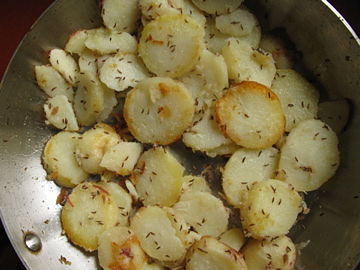
Photo: Regina Hanemann
After our last post (about making Berches, Jewish ceremonial bread, in Berlin), we received a surprise in the form of the photo above. It was sent to us in an e-mail from Dr. Regina Hanemann, director of the municipal museums of Bamberg. It is a Mohnberches (Mohn = poppy seed) that she purchased at the Bäckerei Kerling, a family-run bakery in this small Bavarian city – which happens to be Gaby’s birthplace. What is surprising is that virtually nobody in Germany remembers what Berches is anymore, yet this bakery continues to make it, fully aware of its Jewish background. We do not know whether any of the Jews living in Bamberg today (most of whom are originally from Eastern Europe) buy this bread, which was specific to the Jews of Germany. Dr. Hanemann spoke with the baker, Herr Kerling, who said his father remembers baking it every week for his Jewish clientele. He also said that the dough is the same as the well-known Franconian roll Weckla, though the preparation is different. Dr. Hanemann described the bread as tasting good, though quite neutral, with a fine texture that was denser than other white breads. She also said the inside was very, very white (due to no eggs).
We are posting a recipe here for Berches which is adapted from Herta Bloch. The recipe offers the option of either making two smaller loaves in loaf pans, or forming one larger free-form loaf. Using the pans may be easier for a beginner – the loaves will be guaranteed to rise tall and the braided top will appear over the rim of the pan.
Berches makes 2 loaf pan-sized loaves, or one large free-form loaf. Adapted from Herta Bloch
2 pounds (7 cups) all-purpose flour + extra for bread board
¼ cup + 2 cups lukewarm water, more as needed
1 ¼- ounce package active dry yeast
½ teaspoon sugar
¼ cup neutral oil (such as canola or safflower) + extra for greasing bowl and pan
1 medium white potato (such as russet), cooked, peeled, mashed, and cooled
4 teaspoons kosher salt
1 large egg, lightly beaten
1-2 tablespoons black poppy seeds
1) Place flour in a large bowl and make a well in the center of the flour.
2) Pour ¼ cup lukewarm water in the well. Add yeast and sugar and stir gently to dissolve. Let sit for 5-10 minutes, until it is bubbling.
3) Add the oil, mashed potato, and salt. With a wooden spoon (or your hands), start to mix the flour into the yeast mixture in the well. Gradually add warm water as needed to moisten the flour (being careful not to add too much, the dough should remain firm), while continuing to mix.
4) Remove dough from bowl and put on a floured bread board, or counter. Knead by hand until all the flour is incorporated and the dough is well-blended and smooth.
5) Wash and dry the bowl and grease lightly with oil. Return dough to bowl, cover with a slightly damp kitchen towel and put in a warm spot. Let the dough rise until doubled in size, about 2 hours.
6) Punch down the dough in the bowl. Turn it out onto floured bread board, or counter, and knead until smooth.
7a) For loaf pans: Lightly oil two loaf pans. Cut dough in half. Using first half: cut into 3 equal parts, roll each part into a rope and braid the 3 ropes together. Place in oiled loaf pan. Repeat with other half.
[OR]
7b) For free-form loaf: Lightly oil a cookie sheet. Cut dough into 3 equal parts, roll each part into a rope of equal length. Pinch the ends of the three ropes together and braid the ropes together. Pinch the ends together, and tuck both ends of the braid under. Place loaves on cookie sheet.
8) Cover pans or loaf with moistened towel. Return to warm spot and let rise until doubled in size, about 1-2 hours.
9) Preheat oven to 350° F. Brush top of loaf/loaves with beaten egg and sprinkle evenly with the poppy seeds. Bake in preheated oven for 30-40 minutes, or until the top is light golden brown and the bottom of the loaf makes a hollow sound when tapped with your finger.
10) Let cool on a rack. If using loaf pans, when cool enough to handle, turn loaves out and put on rack to finish cooling.
– Sonya




















